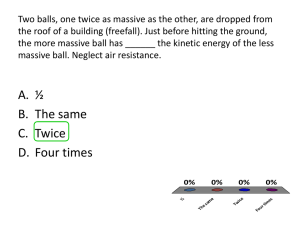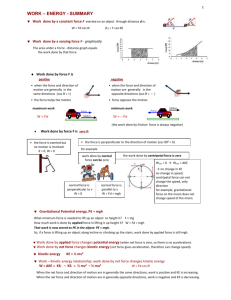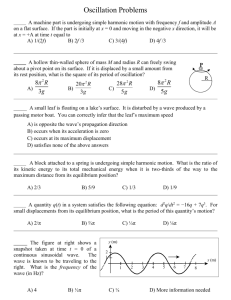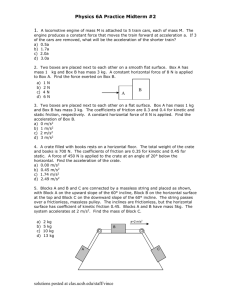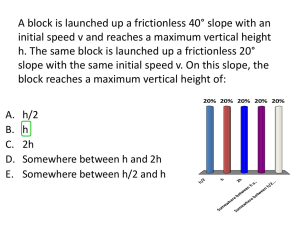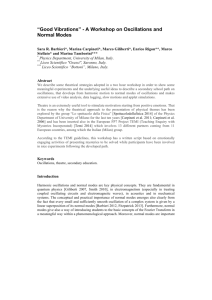day 3 work and energy review
advertisement
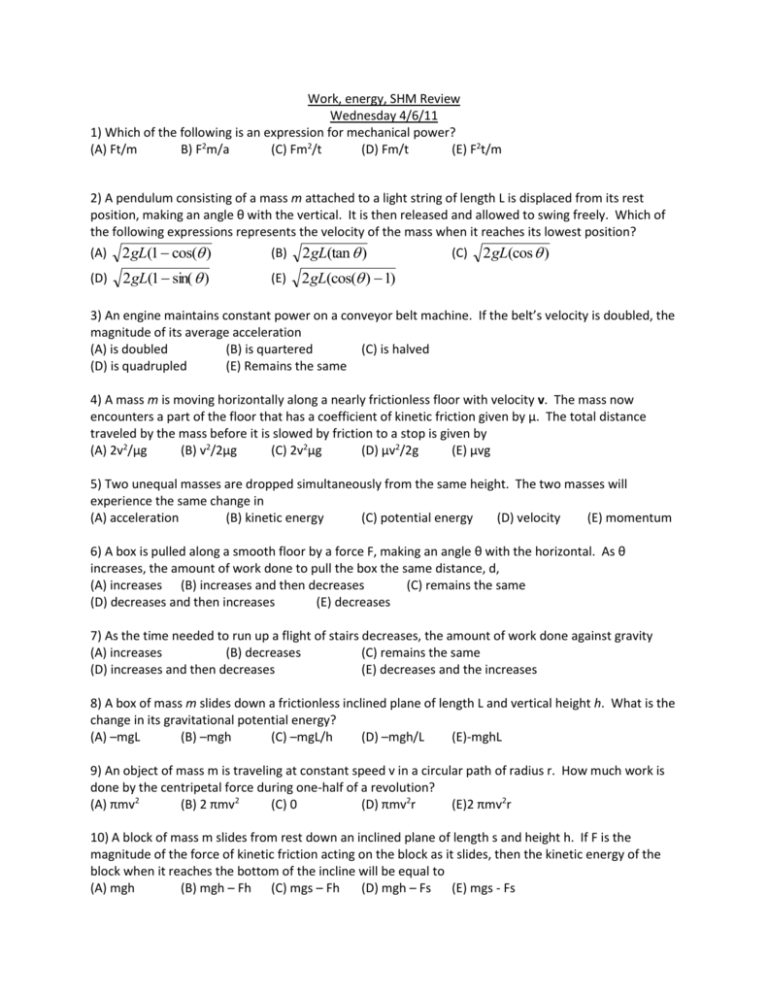
Work, energy, SHM Review Wednesday 4/6/11 1) Which of the following is an expression for mechanical power? (A) Ft/m B) F2m/a (C) Fm2/t (D) Fm/t (E) F2t/m 2) A pendulum consisting of a mass m attached to a light string of length L is displaced from its rest position, making an angle θ with the vertical. It is then released and allowed to swing freely. Which of the following expressions represents the velocity of the mass when it reaches its lowest position? (A) 2 gL(1 cos( ) (B) 2 gL(tan ) (D) 2 gL(1 sin( ) (E) 2 gL(cos( ) 1) (C) 2 gL(cos ) 3) An engine maintains constant power on a conveyor belt machine. If the belt’s velocity is doubled, the magnitude of its average acceleration (A) is doubled (B) is quartered (C) is halved (D) is quadrupled (E) Remains the same 4) A mass m is moving horizontally along a nearly frictionless floor with velocity v. The mass now encounters a part of the floor that has a coefficient of kinetic friction given by µ. The total distance traveled by the mass before it is slowed by friction to a stop is given by (A) 2v2/µg (B) v2/2µg (C) 2v2µg (D) µv2/2g (E) µvg 5) Two unequal masses are dropped simultaneously from the same height. The two masses will experience the same change in (A) acceleration (B) kinetic energy (C) potential energy (D) velocity (E) momentum 6) A box is pulled along a smooth floor by a force F, making an angle θ with the horizontal. As θ increases, the amount of work done to pull the box the same distance, d, (A) increases (B) increases and then decreases (C) remains the same (D) decreases and then increases (E) decreases 7) As the time needed to run up a flight of stairs decreases, the amount of work done against gravity (A) increases (B) decreases (C) remains the same (D) increases and then decreases (E) decreases and the increases 8) A box of mass m slides down a frictionless inclined plane of length L and vertical height h. What is the change in its gravitational potential energy? (A) –mgL (B) –mgh (C) –mgL/h (D) –mgh/L (E)-mghL 9) An object of mass m is traveling at constant speed v in a circular path of radius r. How much work is done by the centripetal force during one-half of a revolution? (A) πmv2 (B) 2 πmv2 (C) 0 (D) πmv2r (E)2 πmv2r 10) A block of mass m slides from rest down an inclined plane of length s and height h. If F is the magnitude of the force of kinetic friction acting on the block as it slides, then the kinetic energy of the block when it reaches the bottom of the incline will be equal to (A) mgh (B) mgh – Fh (C) mgs – Fh (D) mgh – Fs (E) mgs - Fs 11) An astronaut drops a rock from the top of a crater on the Moon. When the rock is halfway down to the bottom of the crater, its speed is what fraction of its final impact speed? (A) 1 4 2 (B) 1 4 (C) 1 2 2 (D) 1 2 (E) 1 2 12) A 0.3kg mass rests on top of a spring that has been compressed by 0.04m. Neglect any frictional effects, and consider the spring to be massless. Then, if the spring has a constant k equal to 2000 N/m, to what height will the mass rise when the system is released? (A) 1.24m (B) 0.75m (C) 0.54m (D) 1.04m (E) 1.34m 13) A block attached to an ideal spring undergoes simple harmonic motion. The acceleration of the block has its maximum magnitude at the point where (A) the speed is the maximum (B) the potential energy is the minimum (C) the speed is the minimum (D) the restoring force is the minimum (E) the kinetic energy is the maximum. 14) A block attached to an ideal spring undergoes simple harmonic motion about its equilibrium position (x = 0) with amplitude A. What fraction of the total energy is the in the form of kinetic energy when the block is at position x = 1/2A? (A) 1/3 (B) 3/8 (C) ½ (D) 2/3 (E) ¾ 15) A student measures the maximum speed of a block undergoing simple harmonic oscillations of amplitude A on the end of an ideal spring. If the block is replaced by one with twice the mass but the amplitude of its oscillations remains the same, then the maximum speed of the block will (A)decrease by a factor of 4 (B) decrease by a factor of 2 (C) decrease by a factor of sqrt(2) (D) remain the same (E) increase by a factor of 2. 16) A spring-block simple harmonic oscillator is set up so that the oscillations are vertical. The period of the motion is T. If the spring and block are taken to the surface of the Moon, where the gravitational acceleration is 1/6 of its value here, then the vertical oscillations will have a period of (A) T/6 (B) T/3 (C) T/sqrt(3) (D) T (E) T*sqrt(6) 17) A linear spring of force constant k is used in a physics lab experiment. A block of mass m is attached to the spring and the resulting frequency, f, of the simple harmonic oscillations is measured. Blocks of various masses are used in different trials, and in each case, the corresponding frequency is measured and recorded. If f2 is plotted versus 1/m, the graph will be a straight line with a slope of (A) 4 2 k2 (B) 4 2 k (C) 4 2 k (D) k 4 2 (E) k2 4 2 18) A simple pendulum swings about the vertical equilibrium position with a maximum angular displacement of 5o and period T. If the same pendulum is given a maximum angular displacement of 10o, then which of the following best gives the period of the oscillations? (A) T/2 (B) T/sqrt(2) (C) T (D) T*sqrt(2) (E) 2T 19) What is the length of a pendulum whose period, at the Equator, is 1s? (A) 0.15m (B) 0.25m (C) 0.30m (D) 0.45m (E) 1.0m 20) If the length of a simple pendulum is doubled, its period will (A) decrease by 2 (B) increase by 2 (C) decrease by sqrt(2) (D) increase by sqrt(2) (E) remain the same Free Response 1) A box of mass m is released from rest at Point A, the top of a long, frictionless slide. Point A is at height H above the level of Points B and C. Although the slide is frictionless, the horizontal surface from Point B to C is not. The coefficient of kinetic friction between the box and this surface is µk, and the horizontal distance between Point B and C is x. (a) (b) (c) (d) Find the speed of the box when its height above Point B is ½ H. Find the speed of the box when it reaches Point B. Determine the value of µk so that the box comes to rest at Point C. Now assume that points B and C are not on the same horizontal level. In particular, assume that the surface from B to C had a uniform upward slope so that Point C were still at a horizontal distance of x from B, but now has a vertical height of y above B. Answer the question in part C. 2) The diagram below shows a roller-coaster ride, which contains a circular loop of radius r. A car (mass m) begins at rest from Point A and moves down the frictionless track from A to B where it then enters the vertical loop (also frictionless), traveling once around the circle from B to C to D to E and back to B, after which it travels along the flat portion of the track from B to F (which is not frictionless). (a) Find the centripetal acceleration of the car when it is at Point C (b) What is the minimum cut-off speed that the car must have at Point D to make it around the loop? (c) What is the minimum height H necessary to ensure that the car makes it around the loop? (d) If H = 6r and the coefficient of friction between the car and the flat portion of the track from B to F is 0.5, how far along this flat portion of the track will the car travel before coming to rest at Point F. Work, energy, SHM Review solutions 1) 2) 3) 4) 5) 6) 7) 8) 9) 10) 11) 12) 13) 14) 15) 16) 17) 18) 19) 20) E A C B D E C B C D E C C E C D D C B D Free response From chapter 4 of Princeton
